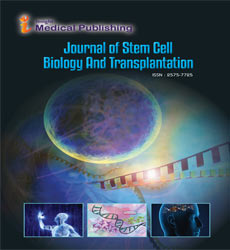ISSN : 2575-7725
Journal of Stem Cell Biology and Transplantation
The Lack of Fam83h Mediated Reduction of Wnt/ò-Catenin Signaling Pathway and Expression Levels of Dental Mineralization Genes
Abstract
Background: FAM83H has been identified as an essential gene for dental enamel formation and may be related to Wnt/β-catenin.
Methods: levels of Fam20a, Dspp, Dmp1, Enam, Ambn, Sppl2a, Mmp20, Fgf10, and the mediators of Wnt/β-catenin pathway were measured in the dental root of both Fam83h-KnockOut and wild-type mice by using Q-PCR at 5,11 and 18 days after birth. The expression of Fgf10 and the mediators of Wnt/β-catenin were also evaluated in the skin of KnockOut and wild-type mice by using Q-PCR and also, The histology of hair follicles was compared. the Fam83h-KnockOut mice recruited in this study confirmed by Sanger sequencing and western blot analysis.
Results: Our results showed that Ambn, Mmp20, Dspp, and Fgf10 significantly reduced in Fam83h-KnockOut mice in the dental root, associated with marked reduction of CK1a, CK1e, and β-catenin expression in Fam83h-KnockOut mice in the dental root. The Fgf10, CK1a, CK1e, and β-catenin were significantly decreased in the skin of Fam83h-KnockOut mice. In the absence of Fam83h, the accumulation of unemployed CK1a is expected to elevate the β-catenin destruction complex. The reduction of CK1e may also decrease the signaling of Dvl-1, leading to the suppression of the Wnt/β-catenin pathway. Simultaneous reduction of both mineralization genes and Wnt/β-catenin pathway due to the absence of Fam83h has a potential to be related to the deficiency of dental formation and mineralization. Further, concurrent reduction of Fgf10 gene expression and Wnt/β-catenin pathway may also affect the maturation of hair follicles as confirmed by histological examination.
Conclusion: it seems that in the lack of Fam83h, dental mineralization is induced by simultaneous decrease of Wnt / β-catenin mediators and the mineralization-related genes, suggesting acting in a cumulative effect manner and probably behaving as a multi-factorial trait.
Open Access Journals
- Aquaculture & Veterinary Science
- Chemistry & Chemical Sciences
- Clinical Sciences
- Engineering
- General Science
- Genetics & Molecular Biology
- Health Care & Nursing
- Immunology & Microbiology
- Materials Science
- Mathematics & Physics
- Medical Sciences
- Neurology & Psychiatry
- Oncology & Cancer Science
- Pharmaceutical Sciences
